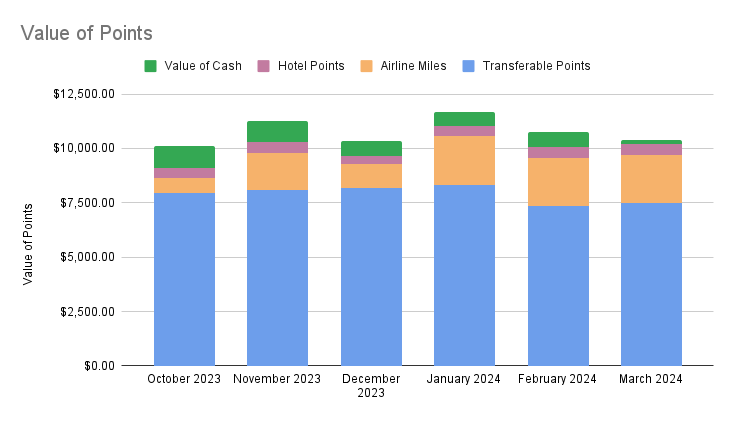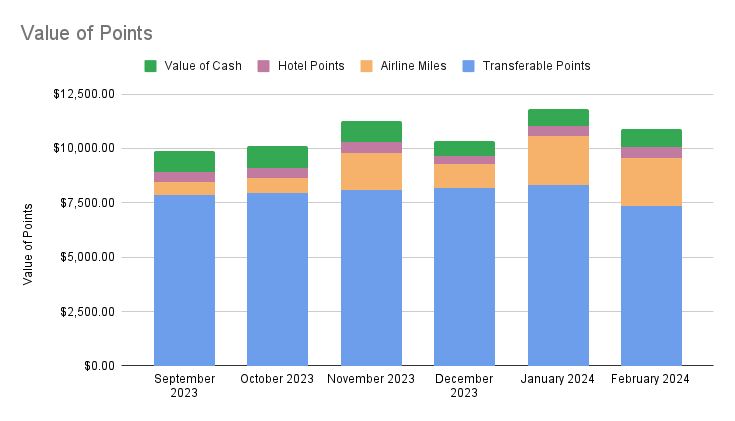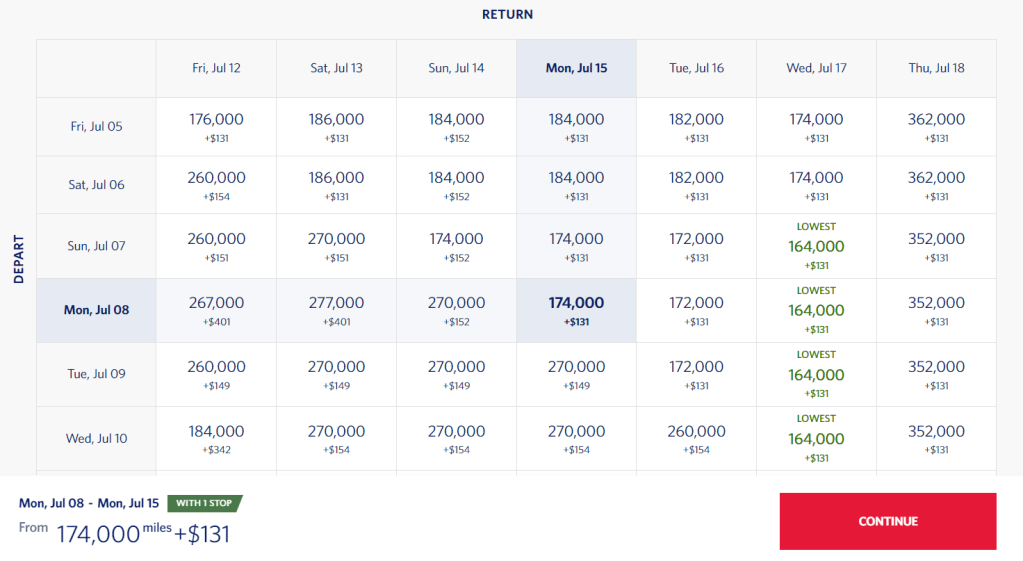
The American Express Blue Business Plus is a somewhat boring, but great all around credit card. It doesn’t come with a big, flashy signup bonus. However, every once in a while, American Express puts out referral bonuses that can make the signup bonus pretty sweet. A recent referral offer from American Express gave us the opportunity to get this must-have credit card and still get a decent bonus.
Why Choose the Amex Blue Business Plus
There main reasons for why the Blue Business Plus is a great option for a business credit card are:
- No Annual Fee
- 2x on all spending up to $50,000 in spending per year
- Earns Membership Reward points that are transferable to 18 airline program and 3 hotel program partners
2x Membership Rewards points per dollar on all spending is great for a no annual fee card. If you are someone who uses multiple credit cards and take advantage of bonus categories to get 5x or 3x on your spending, you notice pretty quickly that not all spending will fall into a bonus category. Having a 2x card that acts as the lowest you earn can be very valuable, especially if you spend a lot in non-bonus categories.
Also, if you like to take advantage of big Amex signup bonus offers on their Gold and Platinum cards, but don’t want to pay the big annual fees for eternity, having the Blue Business Plus card gives you a no annual fee option that allows you to keep those points you earned on those big signup bonuses. This allows you to keep those points and cancel those credit cards. Keep in mind, cancelling an American Express card within 12 months from the date it was issued can cause them to take back the points.
Membership Rewards Transfer Partners
| Program | Type | Transfer Rate |
| Aer Lingus | Airline | 1 MR to 1 Avios |
| AeroMexico | Airline | 1 MR to 1.6 AeroMexico Reward Points |
| Air Canada Aeroplan | Airline | 1 MR to 1 Aeroplan Point |
| ANA Mileage Club | Airline | 1 MR to 1 ANA Mile |
| Avianca Lifemiles | Airline | 1 MR to 1 Lifemile |
| British Airways | Airline | 1 MR to 1 Avios |
| Cathay Pacific | Airline | 1 MR to 1 Asia Mile |
| Delta Skymiles | Airlines | 1 MR to 1 Skymile |
| Emirates Skywards | Airlines | 1 MR to 1 Skyward Mile |
| Etihad Guest | Airlines | 1 MR to 1 Etihad Guest Mile |
| Flying Blue (Air France/KLM) | Airlines | 1 MR to 1 Flying Blue Mile |
| Hawaiian Miles | Airlines | 1 MR to 1 Hawaiian Mile |
| Iberia Plus | Airlines | 1 MR to 1 Avios |
| JetBlue True Blue | Airlines | 5 MR to 4 TrueBlue Points |
| Quantas Frequent Flyer | Airlines | 1 MR to 1 Quantas Point |
| Qatar Airways Privilege Club | Airlines | 1 MR to 1 Avios |
| Singapore Krisflyer | Airlines | 1 MR to 1 KrisFlyer Miles |
| Virgin Atlantic Flying Club | Airlines | 1 MR to 1 Virgin Point |
| Choice Privileges | Hotel | 1 MR to 1 Choice Privilege |
| Hilton Honors | Hotels | 1 MR to 2 Hilton Honors Points |
| Marriott Bonvoy | Hotels | 1 MR to 1 Bonvoy Points |
What makes Membership Rewards points so valuable is being able to take advantage of deals in any of these programs. For example, Flying Blue frequently offers flights from major US cities to Europe for 20,000 points (and around $150 taxes/surcharges) one-way in economy or 50,000 points (and around $250 taxes/surcharges) one-way in business class.
In addition, Virgin Voyages often offers points redemptions on cruises. Recently, they were offering a cruise for 120,000 points per cabin (1 or 2 people) for a seven night Mediterranean cruise leaving from Barcelona with stops in places like Ibiza, Mallorca, and Marseille. Simultaneously, there was also a 30% transfer bonus to Virgin from American Express which means that cruise could have been booked for around 93,000 Membership Rewards points.
Being able to pick and choose between programs when they are running specials is what makes flexible award currencies, such as Membership Rewards so incredibly valuable.
A Place to Keep Your Membership Rewards
American Express offers some monster signup bonuses on their cards. Recently, as Travel On Points pointed out, they offered a 300,000 point signup bonus on their Business Platinum card. That’s just enormous, with that bonus being worth $6,000.
However, the Business Platinum Card has an annual fee of $695. While there are definitely great ways of getting $700 worth of value on that card by using the credits and benefits on that card, eventually you might decide you want to dump the card to avoid that annual fee. By having the Blue Business Plus, you can keep the points you earned on your Business Platinum card in your account without having to pay an annual fee.
But the Signup Bonus for the Blue Business Plus is so Tiny
I have definitely gotten spoiled with signup offers that seem to always be north of 60,000 points. However, I knew if I was going to be trying to get big offers from American Express, I would want the Blue Business Plus in order to house those points. Unfortunately, they almost always offer 15,000 Membership Rewards points on a spend of $3,000 in 3 months – that’s just not exciting.
However, earlier this year, Jenn was given a very enticing offer from American Express. She signed up for the Business Gold card on an inflated 130,000 point offer. Since she was a Business Gold card holder, they offered her a 20,000 point referral bonus as well as 3 months of an additional 10x on dining.
Normally, credit card companies only offer referral bonuses on the same card that the cardholder has, but American Express offers referral bonuses that work if the invitee is approved for other American Express cards as well. This means that Jenn could get a referral bonus on her Business Gold card even though I was getting the Blue Business Plus.
The 20,000 point referral bonus wasn’t that unusual, but the extra 10x on dining was very interesting. Her Business Gold card already earns 4x on dining, which means that for 3 months, she will be earning 14x on every dollar spent on dining.
We don’t eat out that often, maybe a couple of times a month, but we do spend a decent amount of time at breweries. I mean, enough that most of the bartenders we see know us by name. Hey, we like beer. Anyway, breweries code as dining, so those are 14x when using her Business Gold card for the next 3 months.
All in all, lets say that over the next 3 months we spend $2,000 on dining. With the extra 10x, that is 20,000 Membership Reward Points. If you add the 20,000 point referral and the 15,000 point signup, that makes the total signup bonus 55,000 Membership Reward points. That’s pretty good for a no annual fee card, especially one with 2x transferable points on all spending.
Benefits of Working with Someone Else
This is a great example of the importance of working with someone else when earning points and miles. Experienced points and miles hobbyists refer to this as “2-player mode”. Being able to consistently refer a spouse, friend or family member, means that both of you can amass a larger amount of points that you can as an individual. This also means that you shouldn’t be an authorized user on your Player 2’s accounts.
In this case, if I was signing up for this card by myself, I would have earned a 15,000 point bonus. Since we are working in 2-player mode, Jenn will earn around 40,000 points in addition to the points that I’ve earned.
The American Express Blue Business Plus is one of those no-brainer credit cards that should be in your wallet. With 2x Membership Rewards points on all spending up to $50,000 per year and no annual fee, it’s a great card to keep around even if you don’t use it often. American Express has a tendency to give great referral bonuses from time to time, so if you can take advantage of those referral bonuses to bump up that sign up bonus, you should absolutely do so. This is one of those cards that you should have, but be patient to see if you can manufacture an elevated bonus.







